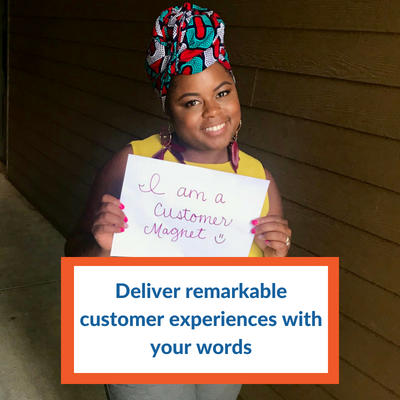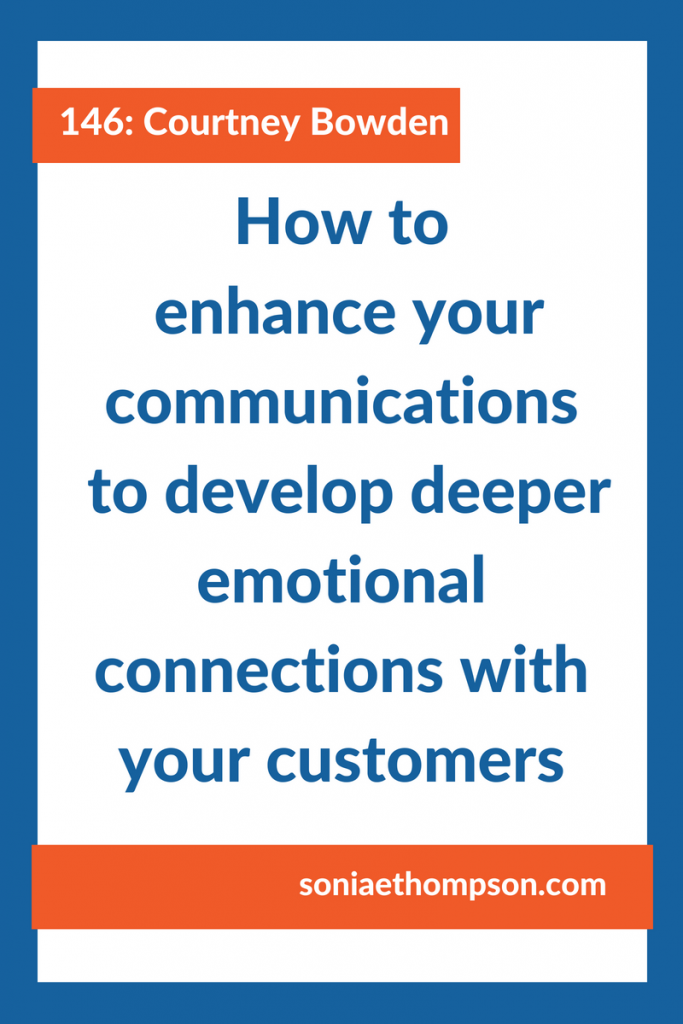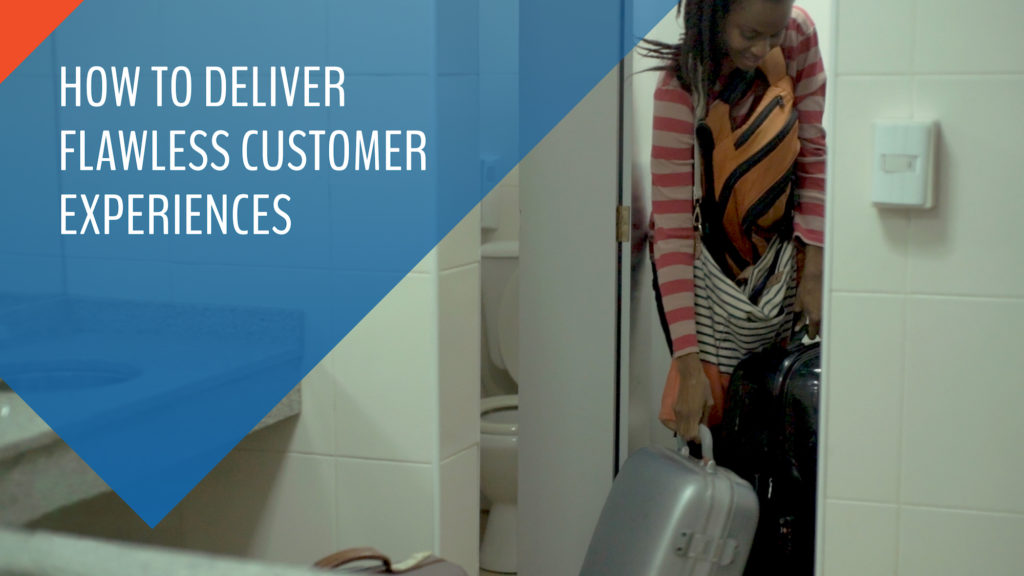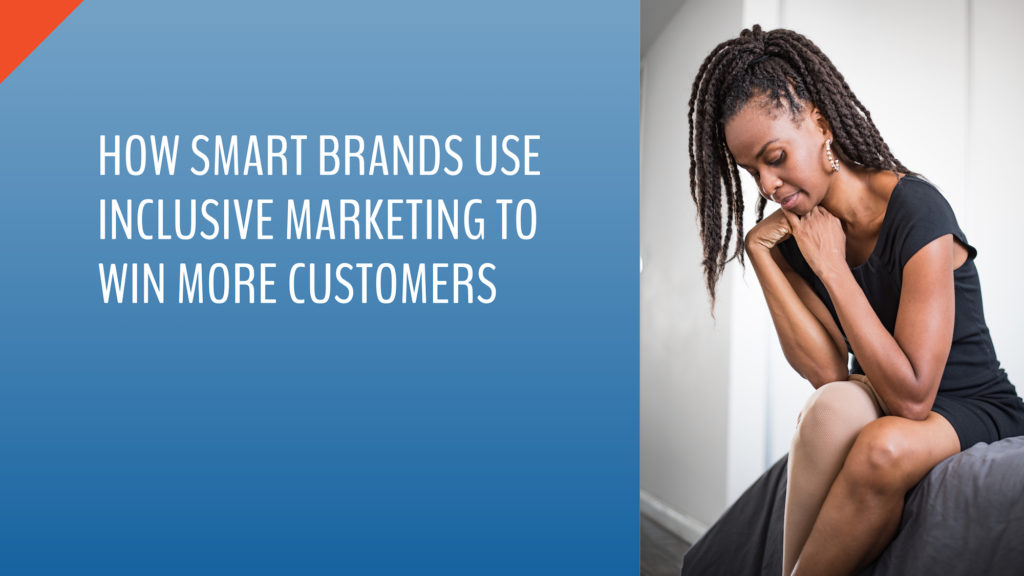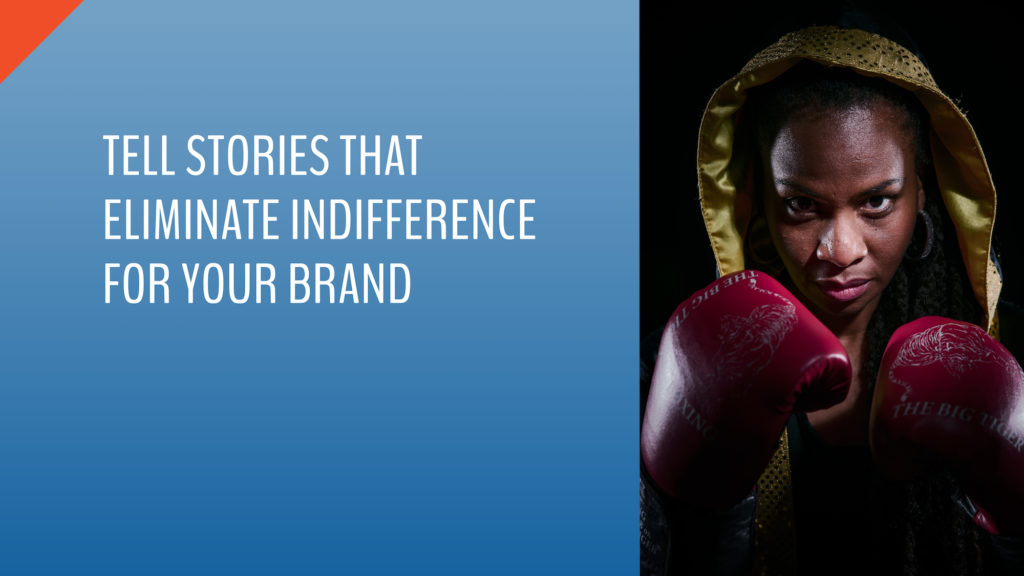Today we are talking about communication, and specifically how to make sure the words you are using connect you to your customers on a deeper level, so they can move further along in their journey with you.
And to dive deeper into this topic, I spent some time chatting with Courtney Herring Bowden, a copywritier who helps businesses deliver magnetic marketing messages.
We can learn a ton from Courtney, in particular, how to develop a strong brand voice that draws your customers to you.
Key points:
- The difference between copywriting and writing
- How copywriting helps you create a deeper emotional connection with your customers
- The types of communications copywriting should be used for to deliver remarkable experiences for your customers
- How to deliver a strong brand voice that helps you connect with your customers at a deeper level (no matter what kind of business you are in)
- The most common mistakes businesses make with their communications and how to fix them
- Why you need to think of your copy as a part of the product experience you deliver to your customers
- Where copy and communication should be considered in your creative process
Listen to the 24-minute episode here:
Watch the episode here:
Read a transcript of the episode below:
How copywriting helps you develop deeper relationships with your customers
Sonia Thompson: Hello, Courtney. Thank you so much for joining me today. How are you?
Courtney Bowden: I’m doing great, Sonia. It’s great to be here. How are you?
Sonia: I’m doing well. All right. Well, let’s go ahead and dive right in. Tell me about your business Courtney Herring.
Courtney: So I am a copywriter and digital marketing strategist. And I partner with purpose driven business leaders to help them skyrocket their bottom line with money making marketing messages, so they can communicate authentically and clearly and attract more clients without compromising their own values or voice.
Sonia: Got it. And you kind of said it, but what is a specific problem that you saw for the people you serve?
Courtney: So really it’s four things. I mostly help my clients discover what their brand voice is and why their message is. I also help them connect authentically with their tribe of customers. And I help them communicate clearly the value of their offers whether it’s a product or a service. And finally, I help them figure out how to inspire more action. Whether it’s getting more subscribers, more followers, more downloads, more purchases, more clicks, what have you.
Sonia: Got it. And I like the last part of it. It says you’re helping them get more action which is of course what we’re trying to do as we work to create a transformation for our customers. We need them to do something.
Courtney: That’s right.
Sonia: So what exactly is copywriting and how does it help business move their customers to take a specific action?
Courtney: So I really define copywriting as both the art and the science of persuading a reader or a listener to take some sort of desirable action. So it’s really important because there’s a difference between copywriting and writing. I think a lot of people often miss it and copywriting has a distinct purpose. It’s to sell ideas or offers and to persuade or inspire an action. Whereas writing can be a lot of things. It can be poetic. It can be entertaining. It can be pleasurable. And I always say that copywriting is always writing but writing isn’t always copywriting.
Sonia: I like that distinction. Yeah, because I think a lot of times when it comes to businesses some of them will get caught up in, maybe this is more some of the smaller businesses that really don’t necessarily hire a copywriter to do their writing projects for them. Because they’re like oh I could just write this. Or we can get someone on our team who’s a good writer to write this. But that’s not the same when you’re trying to move somebody to action.
Courtney: That’s right. That’s exactly right.
Sonia: All right. So how does copywriting work to help businesses deliver remarkable experiences to their customers?
Courtney: Well it does a few things. So copywriting helps businesses create tribes. And it essentially magnetizes the right people to a business and it also repels the wrong people away from it. Next, I believe copywriting creates an emotional connection. So it creates and accelerates the like, know, and trust factors. So we know that people do business with people or brands that they know, like, and trust.
And copywriting helps a company or a business move people from being strangers to being buyers and then eventually being evangelists. And so speaking of which, great copywriting creates loyalty. So that allows customers to run and tell their friends and share what it is that you’re offering enthusiastically. And finally great copywriting helps communicate solutions. So it helps a business position itself as the very best choice to solve their customers problems.
Sonia: Got it. And the experience comes in that it’s not really something, sometimes like you said it’s clearly communicating an idea of a thought or what somebody should do. And other times hopefully it’s a little bit enjoyable to read because I think there are probably far too many business sites or business materials that I’ve read that have just sort of bored me immediately and I’m like I don’t want to read this at all.
Courtney: Right.
Sonia: So yeah, there’s a way to use copywriting to make anything sort of more palatable, digestible.
Courtney: For sure. Absolutely. It can be all of those things that writing is. It can be entertaining. It can be pleasurable. It can be funny. All of it.
Sonia: Okay. Now what types of communications should copywriting be used for within a business?
Courtney: Anything that requires words.
Sonia: Okay.
Courtney: But specifically, it could be websites, sales pages, other landing pages, product descriptions. I think a lot of people who are businesses that have physical products or even digital products sort of underestimate how important it is to have a persuasive product description. It could be the difference between something flying off the shelves or the virtual shelves, or something collecting dust. Also, it’s great for email marketing messages, social media updates, internal company communications. So if you’re trying to build a team or if you’re trying to build great team culture your internal company communications are going to be very important and copywriting helps to get people on board. And finally training programs or even mobile apps.
Sonia: I love how you called out internal communications. Because I know a lot of businesses are really working hard to cultivate the kind of culture that helps them deliver the remarkable or change their culture from one that’s not quite working so well for them. And the words that they use in communicating the transformation that they want to create or the new day that has arrived is very important in enrolling people. So it’s not just about what you’re saying to your customers it’s how you’re communicating with your employees as well. So I really like that you brought that up.
Courtney: Absolutely.
Sonia: All right. So what do you recommend brands do? Because I know that there are a lot of brands who are sort of thought of as hip and cool and they have a very strong brand voice and they might feel like you can make their copywriting, their words, their content, the things that they’re communicating with very fun and have maybe even a bit of a ‘tude sometimes. But then there are other businesses who might say listen that’s not us. We’re more serious. Or the problems that we help people solve they’re not like that fun type of thing. How do you recommend that businesses who might not consider themselves having a strong brand voice work to create a brand voice that could help them deliver remarkable experiences?
Courtney: So that’s a very good question. And I encounter this all the time with my clients. And one thing that’s really important to do is get clear on your why. Get clear on your mission, your purpose, all of those things that make up sort of your brand equity. And also it’s important to figure out how your customers or your client base speak so that you can mirror that. Because if you mirror the way that your ideal client or customers speaks then you can connect with them very easily. And also you want to figure out what are the things that really frustrate them or what are the things that really desire and speak to those things. So that’s what I would recommend a company who is struggling to figure to really understand what that brand voice should be. That’s what I recommend that they do.
Sonia: I like how you brought up it’s just a matter of talking to your customers. And if you think about as you’re talking to your customers the way that you talk to your friends, most people whenever they talk to their friends no matter about what the situation is or whether they think it’s a boring topic or not, they still have a tone of voice that isn’t necessarily going to bore the person that is listening to you as they’re talking you to tears.
Courtney: That’s right. Absolutely. And another thing to add on to that, it’s important to talk about the benefits of your offers whether that’s a product or service instead of focusing so much on the features which is kind of like how it’s delivered and what it’s made of. You want to talk about the end result that a customer can expect to achieve or experience and that can sometimes ignite excitement or enthusiasm.
Sonia: For sure. Now what are some of the biggest mistakes that you’ve seen businesses making with or regards to communicating? And this is whether or not they’ve been using a copywriter.
Courtney: Well, I think one of the number one mistakes is not knowing who they’re talking to. Not understanding their audience beyond just a demographic understanding, age, gender, annual income. It goes deeper than that. You have to understand what is called the psychographics. So I mentioned it a little bit earlier. Their deepest desires and their most fearsome frustrations. What their struggles are. How they’re talking about their struggles. How they’re talking about their desires. That’s something you truly want to understand in order to really put to play those best practices. Or to avoid mistakes. Now the next thing is using a brand voice and communicating a message that doesn’t align with the needs and desires of their audiences. I see it all of the time. And that’s why some people log onto certain company’s websites and feel bored to tears. Or they don’t open up the emails. Or they’re not engaged on social media. It’s because that message, that brand voice doesn’t quite align with what the customer ultimately wants.
The next mistake I see businesses often make is not being painstakingly clear about what the customer can expect to experience or what they expect to get out of a product or a service. And even before they purchase the product or service, I say a lot of businesses drop the ball by not even telling what the customer, or telling the prospect what to do next. So not issuing enough calls to action. And then the next thing is not optimizing their messages. So once you hear from your customer base or your client base it’s important to constantly tweak that message, constantly optimize that message in a way where you’re keeping those customers and those clients engaged.
Why the way you communicate is an extension of your product
Sonia: So if I hear you correctly, I feel like what you’re saying is if you want to deliver remarkable experiences with the words and the copy that you’re using, you have to treat your copy with the same level of care that you treat your product. Because your copy is a part of your product.
Courtney: That’s absolutely right. I would say that is so accurate.
Sonia: Okay. Because I think sometimes it’s maybe considered an afterthought. But as we start to elevate customer experience and see it as as core part of your product that means that elevate every element of it which includes the words that you use. And that sometimes the words that you use are going to meet your customer before your product actually does.
Courtney: That’s so right.
Sonia: Yeah. So you got to make sure that you are putting the right kind of care with the two of them.
Courtney: Absolutely. And I don’t think enough businesses do that because a lot of the focus can be on branding, the sexy stuff, the color palette, the logo. But even before you get to that point you need to figure out what your message is.
Sonia: Got it. So what are some of the other best practices? It sounds like it’s some of the inverses of what you just said. But let’s make it crystal clear for people. What are the best practices and the core things they need to be thinking about when they’re working on their copy to deliver that great experience?
Courtney: So beyond just knowing your audience and who they are, you want to make sure you tailor your messages to reach them at the appropriate part of the customer journey. So you never want to ask for their hand in marriage or ask for the sale when you’re only at the dating phase or when they’re actually only just becoming aware of your business and what it does. The next thing is of course I’m just going to beat this into the ground, but being super clear. Whether that is helping your client or your customer understand the next steps to engage you or how to buy from you or what it is that they can expect. Being clear more than being clever is just so imperative.
The next thing I would say and probably the final thing is incorporating story telling so you can create an emotional connection. So studies show that humans really process information the best way using narratives. And if you use story telling you’ll be able to not only create an emotional connection but your customers and your clients will be able to retain the information that you share with them so much more easily.
Sonia: For sure. I like this. So I think you said this before, but I want to just kind of ask this to get people thinking about this in a different way. Where should copy be considered in the overall creative process for optimal results?
Courtney: That’s a wonderful question. So copy should be considered right after the initial strategy. So you want to make sure you have a goal or a north star that you’re reaching for. But it should definitely come before any design or aesthetics are considered. Because you need that messaging or that tone of voice or that guidance in order to make sure that your branding is on point.
Sonia: Okay. So sounds like you always need to have a copywriter as a part of your strategic team.
Courtney: Absolutely. It’s going to make a huge difference and it’s going to help you help companies save money in the long run because you’re not going to try to retrofit a message into something that you’ve pretty much already created.
How to know if your communications are effective
Sonia: For sure. All right. Now you already said this, that you do consider a copywriting both art and science. But how do you know if it’s effective? How is it that you’re able to measure it or to know like oh we might need to refresh our words? We need to refresh on what’s happening on what we’re saying?
Courtney: So really three ways. Click through rates, engagement, however you gauge that to be, whether it’s the number of likes, shares, comments, and finally sales.
Sonia: Okay. All right. So if you’re meeting a certain threshold. So basically is it testing? Is it meeting a certain threshold or if you’re pleased with where you are? You can kind of keep what you’re doing. Or is it like if it’s just not meeting the mark then you say all right well let’s try something different? Is that how it goes?
Courtney: Yeah. And with a lot of marketing strategies and tactics, often it’s all about testing. So you want to make sure that you’re AB testing, testing one thing against another and making sure that you have sort of a starting point that you can go from. So you can say yes, we were able to get a 3% increase in our sales because of this messaging. Or because of this certain thing. So you want to make sure that you isolate the elements. Copy often interplays very closely with design. So sometimes it can be hard to know which is which because it’s like a marriage. But yeah, isolate the messaging and test it and make sure that you are actually making progress and if not you can always optimize it or tweak it.
Sonia: All right. Courtney, this has been super cool. If anybody wants more information about copywriting, the process, or just to learn more about you, where can people find you?
Courtney: So I can be found at CourtneyHerring.com. And I also run a wonderful engaged Facebook community that’s dedicated to helping companies up level their marketing messages. It’s called the Copy Clinic. And it’s a group that can be found on Facebook. So all you have to do is search. And you can join and just get all of the insights and strategies that I have to offer there.
Sonia: Sweet. And if you’ll send me the link I will put it in the show notes that people can just click on it and go straight to it and find it. So that’ll be super cool. All right. Any parting words of wisdom for business leaders who want to use their words as a way to deliver remarkable experiences to their customers?
Courtney: So I would say to craft a brand message that really sticks and that really sells it’s important to leverage the best parts of either your personality if you’re a consultant or your company if you have an organization and lean into them to create emotional connections that eventually lead to transactions. So think about creating connections first and then transactions will ultimately, and almost inevitably follow.
Sonia: Got it. I know I said that was the end but I do want to just kind of follow up on this one thing about creating emotional connections. What is the balance in being able to do that versus because this is a thing that a lot of brands struggle with, and I know a lot of the bigger brands in particular they’re like you got to be talking about our product. But talking about your product all the time doesn’t necessarily lead to that emotional connection. So how do you recommend that brands strike that balance of of course having the right product discussions but with communicating with words that actual create that deeper bond and connection?
Courtney: Yeah, so I think that’s another great question. And it is a balance. But I think that businesses should always lead with adding value. So if talking about your product online whether it’s social media or what have you does not ultimately add value to the conversation. Then perhaps you need to rethink how you discuss your products. So because right now we’re in a very interesting space in marketing and customers are becoming very savvy and so they’re really concerned with aligning themselves or purchasing from companies that are invested in pleasing them. They’re invested in engaging them.
And so you need to, or companies should be very intentional about creating those connections and again when you create connections it really does open the door for you to talk about your products. And I believe that sales is a service. So when you’re talking about your products and services it’s important to position them as solutions to a specific problem. And so again once you create those connections you can then talk about the solutions that you have and then that’ll ultimately lead to more growth in sales.
Sonia: Love it. All right. Courtney, thank you again for sharing all your wisdom. This has been super insightful.
Courtney: My pleasure, Sonia.
Show notes:
- CourtneyHerring.com
- Courtney’s Facebook group, The Copy Clinic
Free Mini-Course: The Customer Magnet Playbook
Free Mini-Course: The Customer Magnet Playbook
7 Essential elements your business needs to consistently win more customers
- Framework based upon in the trenches experiences from 150+ business and thought leaders
- Science-based explanations to support why the elements of the blueprint work
- Action items to help you get some quick wins

